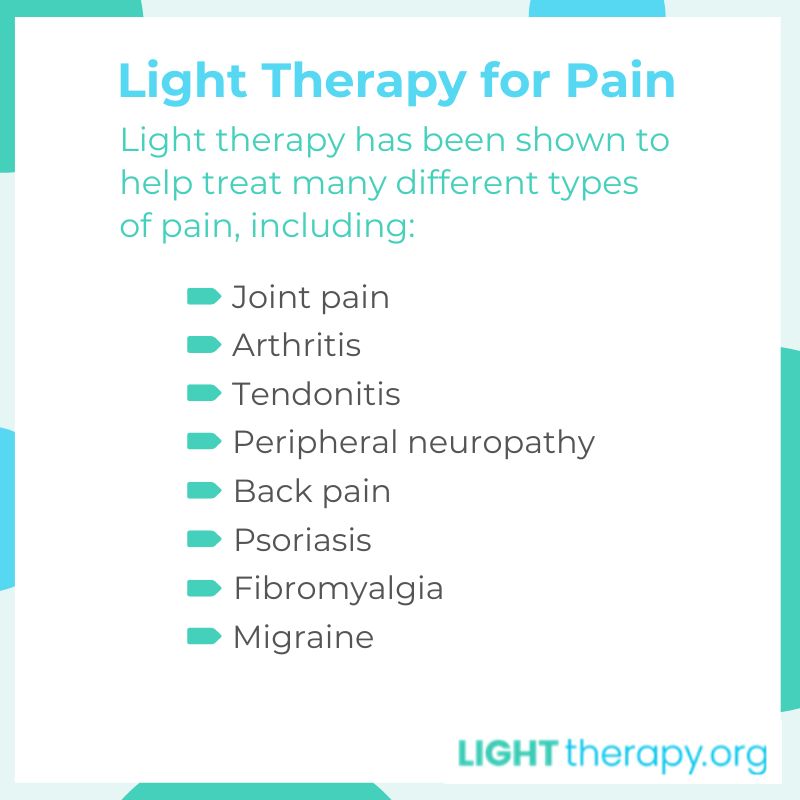What We Know About Light Therapy for Pain and Inflammation
Light therapy is widely known for its beneficial effects on a wide array of conditions, including acne and even seasonal affective disorder.
But what about light therapy for pain and inflammation? Is there any merit to claims that light therapy can successfully treat these conditions?
What Is Light Therapy?
Light therapy, also called photobiomodulation, is a relatively recent field of study, though it has been around in various forms for at least 100 years. In the 1990s, NASA found that certain wavelengths of light, when isolated, could produce specific beneficial health effects in people. Since then, research into light therapy has expanded greatly.
In the last decade or so, light therapy’s rising popularity and technological advancements have made this treatment more accessible and affordable to the average person. Home-use devices designed with light-emitting diodes (LEDs) emit select wavelengths of light to treat targeted areas of the body without requiring a visit to an expensive medical or cosmetic facility.
All About Pain
The International Association for the Study of Pain (IASP) defines pain as “an unpleasant sensory and emotional experience associated with actual or potential tissue damage, or described in terms of such damage.” They also specify that pain is subjective to the person experiencing it.
Pain has a variety of causes, including injury, muscle tightness, infection, neurological issues, and certain chronic illnesses. While some pain is inevitable, light therapy offers tremendous benefits and possible relief for many types of pain.
Light Therapy for Pain
Although pain is difficult to describe and quantify, it has an enormous effect on the body. The human body has specific pain receptors: nerve endings that only respond to pain stimuli. Although the anatomy and physiology of pain can be difficult to wrap your head around, it’s a field of research that benefits all of us, since we all experience pain.

Light therapy has been shown to help treat many different types of pain, including:
The mechanisms by which light therapies relieve pain aren’t always known, such as with green light therapy for migraine and fibromyalgia. Research is ongoing, however, and some therapies are more established than others.
Light Therapy for Degenerative Osteoarthritis
One study evaluated light therapy’s effect on pain and disability in older adults with degenerative osteoarthritis of the knee. Fifty patients diagnosed with degenerative osteoarthritis in both knees received either red light therapy, infrared (IR) light therapy, or a sham light treatment. Each participant applied the assigned treatment to both sides of their knee for 15 minutes, twice a day for 10 days.
The groups receiving red and IR light therapy experienced a more than 50% improvement in pain and disability levels, while the placebo group experienced no change.
A larger study compared the effects of light therapy, electrical stimulation, and placebo on knee osteoarthritis. Researchers found that photobiomodulation alone or in conjunction with electrical stimulation could reduce arthritis pain in patients both during movement and at rest.
Red Light Therapy for Back Pain
A meta-analysis of several studies on chronic low back pain revealed significantly reduced back pain scores in patients treated with light therapy compared to participants who received a placebo light treatment.
In one small study, participants with low back pain received naproxen as a pain reliever along with laser light treatments or placebo treatments. Both groups experienced improvement in back pain, but the results only persisted for many months in the light therapy group, even after discontinuing treatment.
In another small study, participants with low back pain received infrared therapy or placebo from a waistband. The patients who received infrared therapy reported significantly reduced pain and no side effects.
You can learn more about light therapy for back pain here.
Red Light Therapy for Inflammation
One common source of pain and other health problems is inflammation, which often accompanies acute injuries, chronic illnesses, and other conditions. The specific form of photobiomodulation that uses light wavelengths from the red and near-infrared spectrum is particularly effective at addressing inflammation.
A 2017 review published in AIMS Biophysics discusses the effectiveness of red light therapy for inflammation, noting that “One of the most reproducible effects of PBM [photobiomodulation] is an overall reduction in inflammation, which is particularly important for disorders of the joints, traumatic injuries, lung disorders, and in the brain.” The authors also mention that “PBM can reduce inflammation in the brain, abdominal fat, wounds, lungs, spinal cord.”
Another recent study published in Scientific Reports found that low-dose light therapy sped up recovery from burns in mice by reducing inflammation and promoting new tissue formation and healing.
In addition to many scientific studies supporting the use of red light therapy for inflammation, much anecdotal evidence is available.
A November 2017 article in Prevention Magazine, for example, features a marathon runner who strained her Achilles tendon. Frustrated with her inability to heal, she took the advice of her friend, a professor of biomedical sciences, and tried at-home red light therapy along with physical therapy. The treatment worked, and she was back to running marathons within a few months.
The Future of Light Therapy
Evidence is mounting in support of light therapy for pain and red light therapy for inflammation, but research is ongoing. New studies are constantly searching for the exact mechanisms and benefits of light therapy and watching for any adverse effects.
One major benefit of light therapy is the consensus that it’s an incredibly safe and well-tolerated form of treatment. So while you should always consult your physician about any chronic pain or inflammation, light therapy should be a safe avenue to explore along with your doctor’s recommendations.